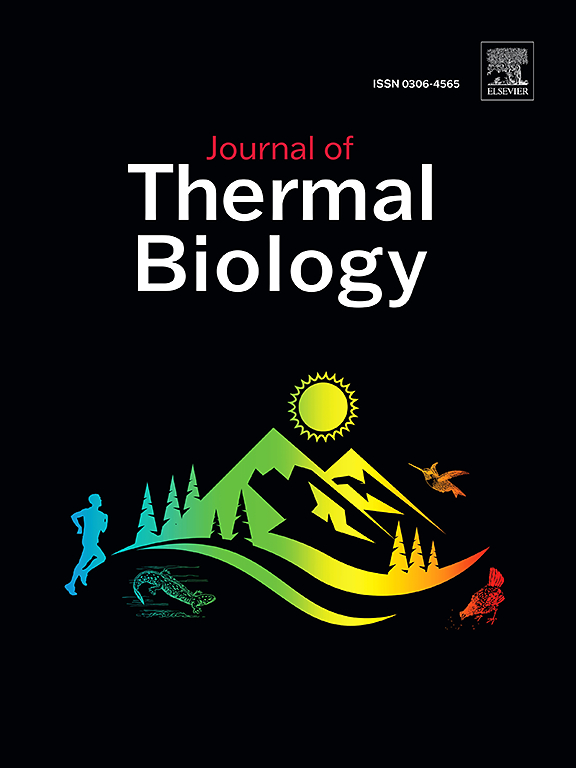黄鲈骨骼发生的个体发生及早期热环境对骨骼发育的影响
IF 2.9
2区 生物学
Q2 BIOLOGY
引用次数: 0
摘要
环境温度对硬骨鱼早期发育的个体发育有重要影响,因为环境温度对生长速率、细胞分化和代谢有不同的影响。因此,环境温度可以导致身体生理和解剖成分(包括骨形成)相对发育速率的变化。个体发育或骨骼形成速率的变化可导致形态或生理表型的变化,并可能影响觅食和躲避捕食者的形式和功能关系。本研究考察了黄鲈的正常骨骼个体发育,评估了黄鲈幼虫和幼鱼的轴向骨骼、颅面区域和鳍的发育。黄鲈骨骼发生的个体发生与其他近缘种具有可比性。鱼也在12、15或18°C的恒定温度下饲养,以检查发育温度的影响;孵化后的鱼被移到普通的18°C。温暖的孵育温度(15°C和18°C)增加了所有身体区域某些骨骼的骨化程度,特别是在外源喂养和幼鱼前(孵化后30和40天)。这在骨化的程度和骨化的分生特征的计数上都是明显的。在12°C条件下饲养的40 dph鱼的骨化和分生细胞计数明显较低,这可能限制了下颚功能,表明脊柱和鳍未发育。未来的研究应该调查游泳表现和觅食,以确定骨骼发育延迟是否有潜在的健康成本。本文章由计算机程序翻译,如有差异,请以英文原文为准。
Ontogeny of skeletogenesis in yellow perch and effects of early thermal environment on bone development
Environmental temperature has a major impact on ontogeny of early development in teleost fish because of differential effects on rates of growth, cellular differentiation, and metabolism. Environmental temperature can thus lead to changes in relative rates of the development of physiological and anatomical components of the body including bone formation. Changes in ontogeny or rate of skeletogenesis can lead to variations in morphological or physiological phenotypes and may affect the relationship of form and function for foraging and predator avoidance. This study examined the normal ontogeny of skeleton in yellow perch, assessing development of the axial skeleton, the cranio-facial region, and the fins, in yellow perch larvae and pre-juveniles. The ontogeny of skeletogenesis in yellow perch was comparable to other related species. Fish were also reared at constant temperatures of 12, 15, or 18 °C to examine the influence of developmental temperature; post-hatch fish were moved to a common 18 °C. Warm incubation temperatures (15 and 18 °C) increased the extent of ossification for some bones in all body regions, particularly in the exogenous feeding, and the pre-juvenile fish (30 and 40 days post hatch). This was evident in both the extent of ossification and counts of meristic characters of ossified bones. Significantly lower ossification and meristic counts in 40 dph fish reared at 12 °C may limit jaw functionality and suggests an undeveloped vertebral column and fins. Future studies should investigate swim performance and foraging to determine if delayed bone development has potential fitness costs.
求助全文
通过发布文献求助,成功后即可免费获取论文全文。
去求助
来源期刊

Journal of thermal biology
生物-动物学
CiteScore
5.30
自引率
7.40%
发文量
196
审稿时长
14.5 weeks
期刊介绍:
The Journal of Thermal Biology publishes articles that advance our knowledge on the ways and mechanisms through which temperature affects man and animals. This includes studies of their responses to these effects and on the ecological consequences. Directly relevant to this theme are:
• The mechanisms of thermal limitation, heat and cold injury, and the resistance of organisms to extremes of temperature
• The mechanisms involved in acclimation, acclimatization and evolutionary adaptation to temperature
• Mechanisms underlying the patterns of hibernation, torpor, dormancy, aestivation and diapause
• Effects of temperature on reproduction and development, growth, ageing and life-span
• Studies on modelling heat transfer between organisms and their environment
• The contributions of temperature to effects of climate change on animal species and man
• Studies of conservation biology and physiology related to temperature
• Behavioural and physiological regulation of body temperature including its pathophysiology and fever
• Medical applications of hypo- and hyperthermia
Article types:
• Original articles
• Review articles
 求助内容:
求助内容: 应助结果提醒方式:
应助结果提醒方式:


